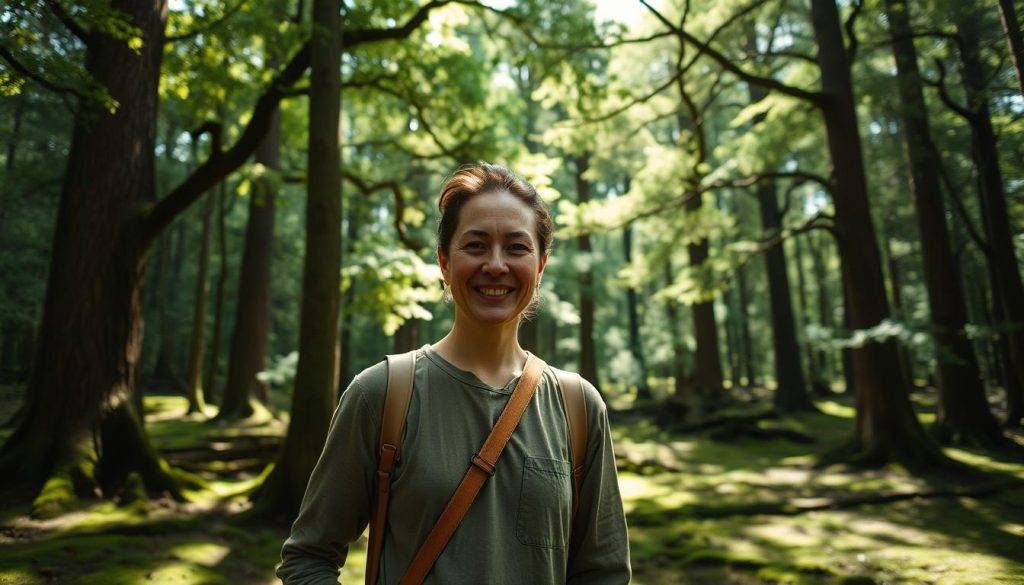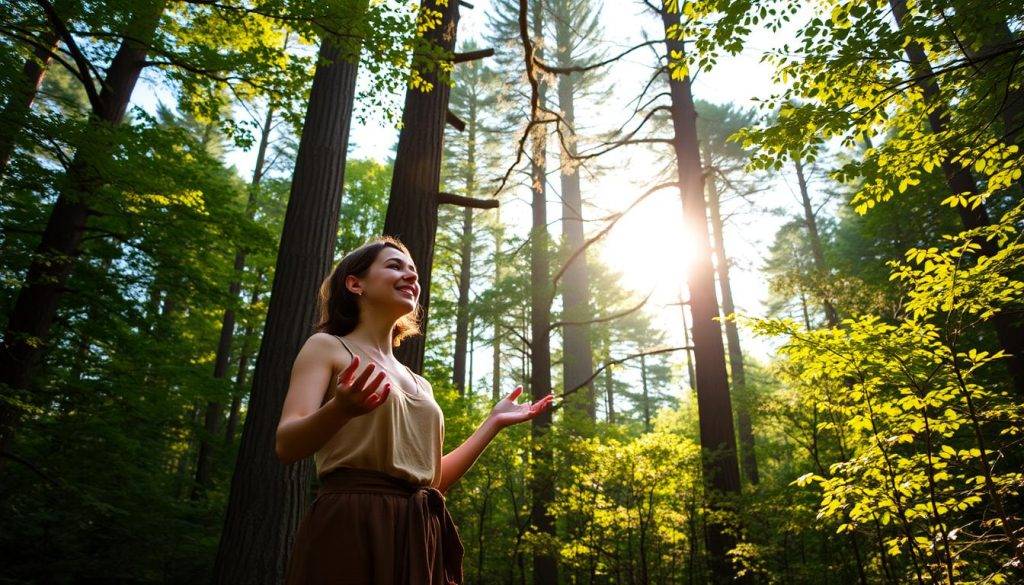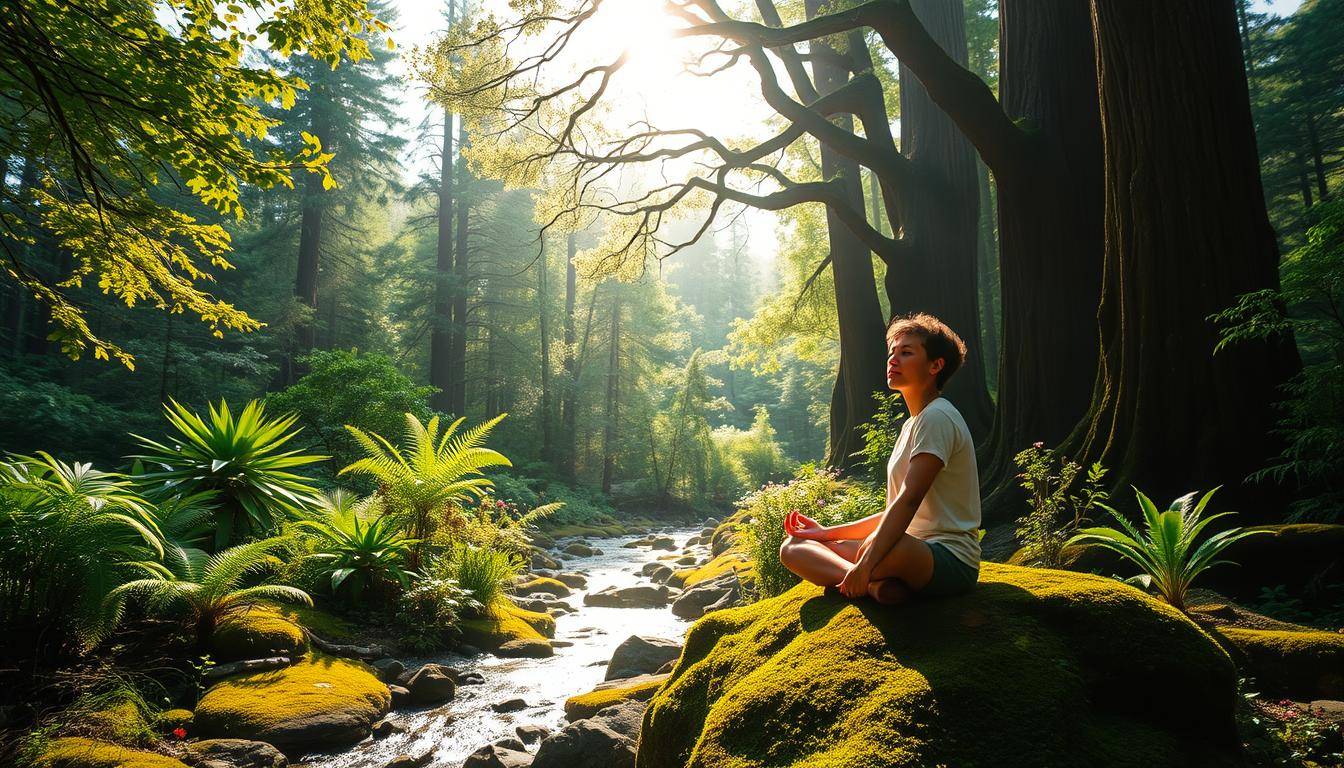“In every walk with nature, one receives far more than he seeks,” observed naturalist John Muir. This truth lies at the heart of forest bathing, a Japanese wellness practice now embraced worldwide as an antidote to modern stress.
Developed in 1980s Japan, this therapeutic immersion in wooded environments addresses tech-era burnout through sensory engagement. Unlike rigorous hikes or nature sports, it emphasizes slow, mindful presence among trees. You don’t need special gear—just openness to nature’s rhythms.
Scientific studies reveal remarkable benefits. Phytoncides (natural tree compounds) boost immunity, while forest sounds lower cortisol levels. The practice bridges ancient wisdom with cutting-edge research, offering measurable stress reduction and mental clarity.
What began as Japan’s eco-wellness movement now helps urban dwellers globally reconnect with Earth’s healing power. As screens dominate daily life, forest bathing provides a reset button—a chance to trade notifications for birdsong and deadlines for dappled sunlight.
Key Takeaways
- Originated in Japan as a response to technology overload and environmental advocacy
- Reduces stress hormones while enhancing immune function through natural compounds
- Requires no equipment—focuses on mindful presence rather than physical exertion
- Supported by over 40 years of medical research on nature’s therapeutic effects
- Adaptable to any wooded area, making wellness accessible worldwide
Understanding Shinrin-yoku and Forest Bathing
Japan’s innovative response to modern challenges birthed a wellness revolution. In 1982, as technology reshaped daily life, the Forest Agency created forest bathing—a structured exercise in sensory awareness. This wasn’t just strolls through trees, but a deliberate strategy to heal urban stress and protect wilderness.

Origins in Japanese Culture
Traditional reverence for nature met modern science. The practice drew from Shinto beliefs about sacred forests and Buddhist mindfulness techniques. Researchers identified specific benefits: lowered blood pressure after 40 minutes among cedar trees, improved mood near flowing streams.
Evolution of the Practice
What began as local ecotherapy became global. By the 1990s, Japanese scientists proved phytoncides—wood oils—boost white blood cells. Today, certified guides worldwide lead sessions blending meditation with environmental education. The art now helps office workers in New York and hikers in Norway alike.
This evolution shows how ancient wisdom adapts. Forest bathing isn’t just about being in nature—it’s about letting nature transform you. As cities grow, this practice offers a bridge between concrete jungles and living ecosystems.
Exploring the Health Benefits of Forest Bathing
Research reveals forest bathing offers more than fresh air—it recalibrates your biology. Studies from Nippon Medical School show spending time among trees decreases cortisol by 16% and enhances immune cell activity by 40%. This science-backed therapy works through multiple pathways, from inhaled tree compounds to sensory relaxation.

Boosting Mental Wellness
Chronic stress melts away when you engage your senses in wooded environments. A 2023 study found participants gained 42 minutes more nightly sleep after three forest bathing sessions. The practice reduces anxiety symptoms as effectively as mindfulness meditation, but without requiring focused concentration.
Dr. Qing Li’s research demonstrates how phytoncides—protective oils released by trees—stimulate relaxation brainwaves. These natural chemicals lower heart rate while improving emotional resilience. Patients report lasting mood improvements, even weeks after their nature immersion.
Improving Physical Health
Your immune system gets stronger with every breath beneath the canopy. Phytoncides increase natural killer cells by 50% for up to 30 days, creating lasting health benefits. Regular practitioners show 12% lower blood pressure and reduced inflammation markers.
| Benefit Type | Key Effects | Duration |
|---|---|---|
| Mental Wellness | 42% better sleep quality | 3+ weeks |
| Physical Health | 50% more immune cells | 1 month |
| Stress Response | 16% cortisol reduction | Immediate |
This holistic approach addresses modern health challenges at their root. By combining sensory engagement with biochemical responses, forest therapy offers measurable improvements you can’t achieve indoors.
How to Practice Shinrin-yoku: A Step-by-Step Guide
Ready to transform your nature walks into healing experiences? This forest bathing guide turns ordinary woodland visits into intentional wellness practices. Unlike casual hikes, it’s about deepening your bond with nature through deliberate sensory engagement.

Preparing for Your Forest Bathing Experience
Begin with a digital detox—leave phones and smartwatches behind. Choose a wooded area with minimal human noise. Research shows quiet environments amplify mindfulness benefits by 37% compared to urban parks.
| Step | Action | Key Benefit |
|---|---|---|
| 1 | Disconnect devices | Enhances sensory awareness |
| 2 | Wear comfortable shoes | Encourages slow movement |
| 3 | Set simple intentions | Reduces performance pressure |
Embracing Mindfulness in Nature
Start your walk by tuning into sounds—bird calls, rustling leaves, or distant water. Breathe deeply to absorb phytoncides in the air. Let your fingers brush tree bark or moss-covered stones.
“True mindfulness happens when we let nature direct our attention,” notes wilderness therapist Mara G. Freeman.
Move without rushing. If a sunlit clearing catches your eye, pause. Notice how shadows play across the ground. This experience isn’t about distance covered—it’s about awakening your senses to nature’s subtle rhythms.
shinrin-yoku: Tips and Techniques for Beginners
Modern life keeps 93% of our time indoors, according to Dr. Qing Li. This guide helps you reclaim nature’s benefits through accessible forest bathing practices. Unlike formal meditation, the woods naturally guide your attention to rustling leaves or shifting sunlight.

Digital Detox Essentials
True disconnection means more than silencing notifications. Create mental boundaries by leaving devices in your car. Studies show this simple act boosts mindfulness effectiveness by 29% compared to keeping phones on silent.
| Strategy | Action | Benefit |
|---|---|---|
| Pre-Session Prep | Write down urgent contacts | Reduces anxiety about disconnecting |
| Transition Ritual | Take 5 deep breaths at trailhead | Signals brain to switch modes |
| Post-Session | Wait 15 minutes before checking devices | Extends calm effects |
New practitioners often struggle with slow pacing. Try this trick: match your steps to breathing rhythms. Inhale for three steps, exhale for four. This plan eases restlessness while deepening your sense of connection.
Dr. Li suggests starting with 20-minute sessions. “Let the forest work through small things—a breeze on your neck, pine scent, uneven ground beneath your feet.” These micro-experiences build focus without effort.
Remember, forest bathing isn’t about perfect technique. It’s about showing up and letting green spaces work their magic. Your guide to wellness grows clearer with each visit.
Discovering Top Forest Bathing Destinations
From misty Japanese cedar groves to New York’s evergreen wilderness, exceptional forest bathing spots exist across six continents. These destinations combine natural beauty with therapeutic benefits, offering travelers immersive wellness experiences rooted in science and tradition.

Japan’s Natural Sanctuaries
Iiyama’s forests in Nagano Prefecture became Japan’s first certified healing woods in 2005. Situated 500 meters above sea level, these beech and cedar groves release phytoncides at optimal concentrations. Near Tokyo, Mt. Mitake’s sacred cedars and Meiji Shrine’s 36,000-tree oasis prove urban escapes can be transformative.
Global Forest Experiences
New York’s Adirondack Park—larger than Yellowstone and Yosemite combined—boasts pine forests with certified guides. Costa Rica’s rainforests demonstrate sustainable travel principles, where 50% forest coverage protects biodiversity while welcoming visitors. Kenya’s community-led walks and New Zealand’s ancient kauri groves offer cultural connections alongside natural healing.
| Location | Key Features | Therapeutic Benefits |
|---|---|---|
| Nikko National Park, Japan | 1,150 sq. km UNESCO site with maple/oak forests | Combines cultural history with air quality improvements |
| Waipoua Forest, NZ | 2,000-year-old kauri trees | Enhances creativity through unique ecosystem exposure |
| Adirondack Park, USA | 6 million protected acres | Evergreen phytoncides boost immune function |
| Matthews Range, Kenya | Community-guided forest walks | Reduces stress through social-nature connection |
When planning travel for forest therapy, prioritize locations supporting conservation. Hawaii’s native forests and Costa Rica’s eco-lodges prove wellness tourism can protect ecosystems while offering life-changing experiences. These destinations remind us that healing grows naturally where humans tread lightly.
Urban Escapes: Integrating Nature into City Life
Concrete jungles challenge wellness seekers with relentless noise and scarce greenery. Yet forest bathing thrives in metropolitan areas through intentional engagement with urban nature. Tokyo proves even bustling cities harbor sanctuaries—like Meiji Shrine’s 36,000-tree oasis steps from Harajuku Station.
Finding Green Oases in the City
Successful urban forest bathing begins by redefining what constitutes nature. Mature parks, tree-lined streets, and rooftop gardens become therapeutic spaces when approached mindfully. The Institute for Nature Study in Tokyo’s Minato-ku demonstrates how marshlands coexist with skyscrapers, offering breathing room from urban chaos.
Morning commuters can transform routine walks by noticing trees along sidewalks. Lunch breaks gain new purpose when spent under canopy shade rather than fluorescent lights. Research shows 20-minute sessions in pocket parks lower stress hormones as effectively as longer travel to wilderness areas.
Urbanites maximize benefits by engaging multiple senses simultaneously. Trace bark textures with fingertips while inhaling petrichor after rain. Let bird songs override traffic hum. These micro-practices build resilience against city stressors without requiring lifestyle overhauls.
Every forest fragment holds potential—from home window boxes to corporate courtyards. By reframing urban landscapes as networks of natural centers, city dwellers unlock daily opportunities for renewal. Consistency matters more than location size when cultivating nature-connected habits.
FAQ
How does forest bathing differ from regular hiking?
Unlike goal-oriented hiking, forest bathing emphasizes sensory immersion rather than physical exertion. Participants focus on breathing patterns, tactile experiences with leaves/bark, and absorbing natural sights/sounds without distance targets.
Can urban dwellers practice shinrin-yoku effectively?
Yes – cities like New York and Singapore offer curated urban forest therapy trails. Research shows even brief exposure to pocket parks or tree-lined streets reduces cortisol levels when approached with mindful observation techniques.
What gear enhances a forest bathing experience?
Essentials include weather-adaptive layers from brands like Patagonia, a portable sitting pad from REI, and a digital detox kit (phone silencer + analog notebook). Avoid fitness trackers – the practice prioritizes biological rhythms over metrics.
How do seasons affect forest therapy benefits?
Winter sessions amplify coniferous phytoncide exposure (immune-boosting compounds), while autumn engages visual cortex stimulation through color variations. Summer offers fuller sensory engagement, and spring activates renewal symbolism through budding flora.
Are there certification programs for forest therapy guides?
The Association of Nature and Forest Therapy offers 6-month accreditation programs combining ecology studies with mindfulness coaching. Certified guides master techniques like “invitational pacing” and sensory activation sequences.
Can forest bathing complement other wellness practices?
Absolutely. Many practitioners combine it with Japanese yoga (Shinrin-yoku) or Nordic friluftsliv principles. Research from Stanford shows synergy with mindfulness meditation, amplifying attention restoration effects by 37% compared to solo practices.




























































